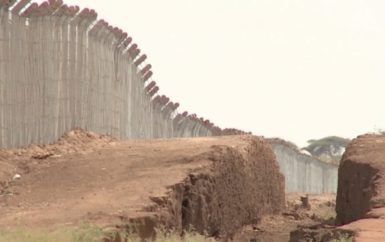Combating Terrorism on the Somalian Border: The Improbable Kenyan Dream?
A customs post taken by storm, its barrier closed for three days, and 25 large bags of khat imported from Kenya in flames. We are in early 2018, in the Somali city of Belet-Hawo on Kenya’s northern border. However, this was no attack by Islamist al-Shabaab terrorists. This demonstration of anger was organised by local leaders to protest against the decision by the Kenyan government to construct the wall. According to them, “the closure of the border had seriously affected the business and the education between Belet-Hawo of Somalia and Mandera of Kenya respectively”.
The Kenyan Government under Pressure
The construction of this wall is an ambitious 700-kilometre-long project in the middle of the desert, a project that might raise a smile if the situation weren’t so tragic. In the desert province of Mandera, where the first few kilometres have been constructed, the security situation has seriously deteriorated in recent years. Since 2013, more than 300 villagers have died as a result of regular incursions by al-Shabaab mercenaries, against whose constant harassment the Kenyan soldiers have proved powerless. Far from being limited to the north, al-Shabaab attacks have also affected the east of the country, from Lamu to Mombasa, the heart of the tourist industry.
The al-Shabaab armed group first appeared in the Horn of Africa in 2006. After being forced from power and from the capital, Mogadishu, in 2011, these 3,000 men are now refugees in the south of Somalia. In addition to looting villages and recruiting their inhabitants by force, these radical Islamists with close ties to al-Qaeda seek with their raids in Kenyan territory revenge against a neighbouring state that declared war on them. Indeed, Kenyan troops entered Somali territory at the end of 2011 to destroy their camps, likely with logistical support from the French and Americans.
 The Kenyan wall.
The Kenyan wall.Nonetheless, it was in the wake of the appalling siege of Garissa University in 2015 – leading to the execution of 148 Christian students – that the Kenyan government announced the construction of this wall, anxious to propose a measure that was immediate, reassuring and popular. “The way America changed after 9/11 is the way Kenya will change after Garissa”, declared Kenyan Vice President William Ruto at the time. After the attack on the Westgate shopping centre in Nairobi in 2013 (68 victims), this was Kenya’s deadliest terrorist act since the bombing of the US embassy in 1998.
The original plans for the construction of the wall have nevertheless been revised downwards. Initially intended to be built out of concrete, the wall has transformed into a double wire fence topped with barbed wire. As planned, the project is expected to cost the Kenyan government more than CHF 2 million per kilometre. In this context, the visit by Israeli Prime Minister Benjamin Netanyahu in November 2017 with promises of Israeli support and expertise in wall construction was only halfway surprising. The Israeli company Magal Security Systems, approached for the construction work, had seen its share price explode since Trump’s electoral victory. The wall is now a business concern.
Closing the Dadaab Camp
There appears to be a consensus in the Kenyan press that the wall is an appropriate option for the purposes of ensuring the country’s security. The Kenyan government, meanwhile, has seen in the wall an opportunity to kill two birds with one stone. Under the pretext of fighting the Shabaab, it aims to stop the uninterrupted flow of refugees who have been fleeing Somalia for the past 10 years. Indeed, putting an end to the arrival of Somali refugees in Kenya would, in concrete terms, bring a solution to the intractable problem of the Dadaab refugee camp in the east of the country, in a semi-arid region along the Somali border.
Managed by the United Nations High Commissioner for Refugees (UNHCR), Dadaab is today the world’s largest refugee camp, making it the 5th largest city in Kenya. Including unregistered refugees, the number of the camp’s occupants reached almost half a million in 2012, having stabilised today at 350,000. In addition to a large majority of Somalis, it includes refugees of various origins: Sudanese, Ethiopian, Congolese, Rwandan and Ugandan.
For domestic security reasons, respective Kenyan governments have never made a secret of their desire to close Dadaab, notwithstanding the efforts of international organisations. The authorities’ decision in May 2016 to close the camp was likewise an attempt to put an end to the suction effect of the UNHCR camp. Nonetheless, a judicial ruling, following a complaint by Kenyan activists, has prevented the camp’s closure, with the Kenyan government’s decision having been declared “null and void” by one of its own courts.
When Theory Bumps Up against Reality
The government’s ambitions appear to have been buried in the desert sands. To date, only 8 kilometres have been constructed at Mandera in the north, and the project that was intended to cover 700 kilometres is at a standstill. Officially, this is a response to the need for negotiation between the public authorities and the Somali populations wishing to be compensated for the planned demolition of their houses located in no man’s land. Unofficially, the task is proving more complicated and more expensive than expected. In addition, Somali nomads on both sides of the border have family connections and very close ties, as a result of their shared history, practices, language, religion and trade. Accustomed to crossing these territories to graze their livestock, some perceive these borderlands as communal rather than state property.
Unsurprisingly, the separation wall has been condemned by the Somali government, which welcomes the recent suspension of construction work, allowing finally for a discussion of the stakes involved.walls rarely solve problems. They reinvent them. For the Somali government, construction of the wall is a “bad idea” that, in addition to encroaching on its territory, is viewed above all as a pretext to put pressure on the International Court of Justice, which is to decide on a dispute over the maritime border between the two countries. The measure is perceived as useless and ineffective against the Shabaab attacks, since, as Somali Minister of Internal Security Abdirizak Mohamed Omar declared in 2015, “most of them are already in Kenya”, referring to the potential terrorists infiltrated among the refugees.
Then, likely in a bid to appease its opponents, a Kenyan government spokesman stated at a press conference that the wall would not cover the whole 700-kilometre border, keen to put the cost of the construction into perspective in a country still lacking public infrastructure.
The Shadows of the Wall
In the words of Abdiwahab Sheikh Abdisamad, a researcher at the Southlink think-tank in Nairobi: “The government is not addressing the root causes of the problem. Al-Shabaab is not only in Somalia. Projects need to be created for those who have become indoctrinated, the trust of the populations needs to be regained. Otherwise this wall will only be a plaster on a gaping wound.” He adds: “You don’t bury an ideology with concrete.”*
A wall is a screen on which both its constructors’ hopes and the constraints and diversions of those who must endure it are projected. In Kenya, should it one day become operational – which is far from certain – the barbed wire border will perhaps reduce attacks by al-Shabaab armed groups. But it will also affect the way in which the two nations perceive and interact with each other. Born from a security concern, it could paradoxically increase instability in the region. For walls rarely solve problems. They reinvent them.
Fact Sheet: The Fence between Kenya and Somalia
Cost: CHF 1,400 million estimated.
Size: 8 km built out of the 700-km-long project.
Origin:
- Following the siege of Garissa University in 2015, the Kenyan government announced the construction of the wall.
- The project was stopped in January 2018 to open negotiations with the Somalian Government.
Refugees and Asylum-Seekers in Kenya by Nationality, 2010–2017
UNHCR Population Statistics, popstats.unhcr.org.
Increasing Number of Walls in the World, 1945–2018
Based on Samuel Granados, Zoeann Murphy, Kevin Schaul and Anthony Faiola, “Raising Barriers: A New Age of Walls”, The Washington Post, 12 October 2016.
United States/Mexico
India/Bangladesh
Kenya/Somalia
South Korea/North Korea
Turkey/Syria
Israeli West Bank Barrier
1,120 km between California and Texas, around a third of the total border length of 3,141 km.
Origins
- In 1994, US Border Patrol installed sensors and stronger fencing in San Diego, California, and El Paso, Texas. In the fall of 2006, the Congress authorised the construction of 700 miles of fencing in rural areas in California and Arizona. In January 2017, President Trump signed an Executive Order to begin the extension of the border wall.
The fence covers 3,200 km of the 4,096.7-km-long border
Origins
- The fence finds its origin in the Assam Accord of 1985 signed between representatives of the Government of India and the leaders of the sub-national Assam Movement. The accord accommodated the claims of the Assam Movement to keep out irregular migrants. The construction of the fence started in 1993.
8 km already done of the 700-km-long project
Origins
- Following the siege of Garissa University in 2015, the Kenyan government announced the construction of the wall.
- Project stopped in January 2018 to open negotiations with the Somalian Government.
764-km-long wall
Origins
- In March 2015, Turkey closed its border with Syria.
- In August 2015, the first section of the border wall was constructed in Reyhanli.
- The wall was completed in June 2018.
The DMZ is 250 km (160 miles) long and about 4 km (2.5 miles) wide.
Origins
- In the Armistice Agreement of 27 July 1953, the DMZ was created as each side agreed to move their troops 2,000 m (2,200 yards) back from the front line, creating a 4-km-wide (2.5-mi-wide) buffer zone.
700 km.
Origins
- The barrier was built in 2002, during the Second Intifada that had begun in September 2000, and was officially justified by the Israeli need of security against the wave of violence.
Definition of “Wall”
“The English word ‘wall’ is derived from the Latin vallus meaning a ‘stake’ or ‘post’ and designated the wood-stake and earth palisade which formed the outer edge of a fortification. Walls have traditionally been built for defense, privacy, and to protect the people of a certain region from the influence or perceived danger posed by outsiders” (from Joshua J. Mark, Ancient History Encyclopedia, https://www.ancient.eu/wall/).
Walls are social constructions that are often used in a metaphorical sense, serving as canvas to cultural and/or political projections. An example in point is the 1979 album The Wall of the progressive/psychedelic rock band Pink Floyd. Physical walls are the offspring of our mental walls but physical walls, in turn, also impact our mental maps and the way we configure spatial identities and alterity.
In academic terms, walls have further been described as “an exercise in verticality” (Carl Nightingale), as “top-down controlled sluices of human movement, points of banishment, and perfect locations for tax collection” (Carl Nightingale), as “material things with symbolic meaning” (Tamar Herzog) and, finally, as “sites of negotiation and practice-making or -following” (Tamar Herzog).
All quotes from Suzanne Conklin Akbari, Tamar Herzog, Daniel Jütte, Carl Nightingale, William Rankin and Keren Weitzberg, “AHR Conversation: Walls, Borders, and Boundaries in World History”, American Historical Review 122, no. 5 (2017): 1501–1553, doi:10.1093/ahr/122.5.1501.




